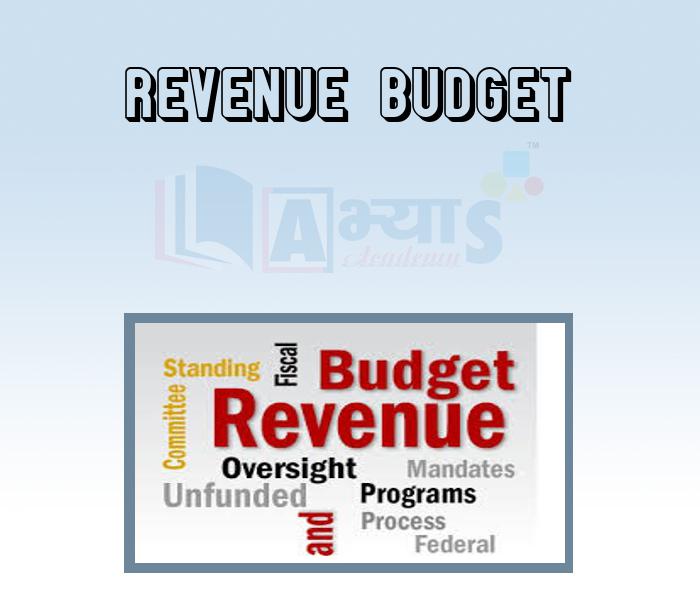Revenue Budget








Revenue Budget
Revenue Budget: This financial statement includes the revenue receipts of the government i.e, revenue collected by way of taxes & other receipts. It also contains the items of expenditure met from such revenue.
(A) Revenue Receipts: These are the incomes which are received by the government from all sources in its ordinary course of governance. These receipts do not create a liability or lead to a reduction in assets. Revenue receipts are further classified as tax revenue and non-tax revenue.
(i). Tax Revenue: Tax revenue consists of the income received from different taxes and other duties levied by the government. It is a major source of public revenue. Every citizen, by law is bound to pay them and non-payment is punishable. Taxes are of two types, viz., Direct Taxes and Indirect Taxes.
Direct taxes are those taxes which have to be paid by the person on whom they are levied. Its burden can not be shifted to some one else. E.g. Income tax, property tax, corporation tax, estate duty, etc. are direct taxes. There is no direct benefit to the tax payer.
Indirect taxes are those taxes which are levied on commodities and services and affect the income of a person through their consumption expenditure. Here the burden can be shifted to some other person. E.g. Custom duties, sales tax, services tax, excise duties, etc, are indirect taxes.
(ii) Non-Tax Revenue: Apart from taxes, governments also receive revenue from other non-tax sources. The non-tax sources of public revenue are as follows :-Fees: The Government provides variety of services for which fees have to be paid. e.g. fees paid for registration of property, births, deaths, etc.
Fines and penalties: Fines and penalties are imposed by the government for not following (violating) the rules and regulations.
Profits from public sector enterprises: Many enterprises are owned and managed by the government. The profits receives from them is an important source of non-tax revenue. For example in India, the Indian Railways, Oil and Natural Gas Commission, Air India, Indian Airlines, etc. are owned by the Government of India. The profit generated by them is a source of revenue to the government.
Gifts and grants: Gifts and grants are received by the government when there are natural calamities like earthquake, floods, famines, etc. Citizens of the country, foreign governments and international organisations like the UNICEF, UNESCO, etc. donate during times of natural calamities
Special assessment duty: It is a type of levy imposed by the government on the people getting some special benefit. For example, in a particular locality, if roads are improved, property prices will rise. The Property owners in that locality will benefit due to the appreciation in the value of property. Therefore the government imposes a levy on them which is known as special assessment duties.(iii) India's Revenue Receipts: The tax revenue provides major share of revenue receipts to the central government of India.
(B) Revenue Expenditure: Revenue expenditure is the expenditure incurred for the routine, usual and normal day to today running of government departments and provision of various services to citizens, It includes both development and non-development expenditure of the Central government Usually expenditures that do not result in the creations of assets are considered revenue expenditure.
Expenses included in Revenue Expenditure:
Students / Parents Reviews [10]
It has a great methodology. Students here can get analysis to their test quickly.We can learn easily through PPTs and the testing methods are good. We know that where we have to practice

Barkha Arora
10thAbout Abhyas metholodology the teachers are very nice and hardworking toward students.The Centre Head Mrs Anu Sethi is also a brilliant teacher.Abhyas has taught me how to overcome problems and has always taken my doubts and suppoeted me.

Shreya Shrivastava
8thA marvelous experience with Abhyas. I am glad to share that my ward has achieved more than enough at the Ambala ABHYAS centre. Years have passed on and more and more he has gained. May the centre flourish and develop day by day by the grace of God.

Archit Segal
7thMy experience with Abhyas academy is very good. I did not think that my every subject coming here will be so strong. The main thing is that the online tests had made me learn here more things.

Hiya Gupta
8thAbhyas is a complete education Institute. Here extreme care is taken by teacher with the help of regular exam. Extra classes also conducted by the institute, if the student is weak.

Om Umang
10thMy experience with Abhyas is very good. I have learnt many things here like vedic maths and reasoning also. Teachers here first take our doubts and then there are assignments to verify our weak points.

Shivam Rana
7thMy experience was very good with Abhyas academy. I am studying here from 6th class and I am satisfied by its results in my life. I improved a lot here ahead of school syllabus.

Ayan Ghosh
8thIt was a good experience with Abhyas Academy. I even faced problems in starting but slowly and steadily overcomed. Especially reasoning classes helped me a lot.

Cheshta
10thIt was good as the experience because as we had come here we had been improved in a such envirnment created here.Extra is taught which is beneficial for future.

Eshan Arora
8thBeing a parent, I saw my daughter improvement in her studies by seeing a good result in all day to day compititive exam TMO, NSO, IEO etc and as well as studies. I have got a fruitful result from my daughter.
